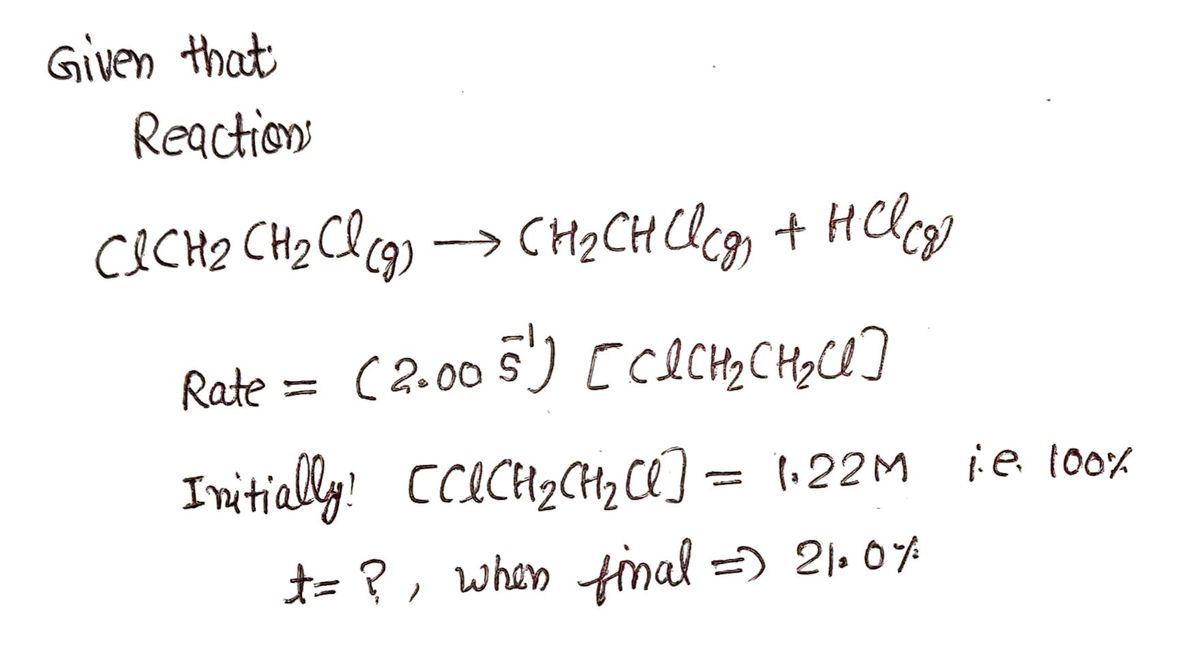Consider this reaction: CICH₂CH₂Cl (g) → CH₂CHCI (g) + HC1 (g) At a certain temperature it obeys this rate law. rate - (2.00 s¹) [CICH₂CH₂CI] S Suppose a vessel contains CICH₂CH₂Cl at a concentration of 1.22M. Calculate how long it takes for the concentration of CICH₂CH₂Cl to decrease to 21.0% of its initial value. You may assume no other reaction is important. Round your answer to 2 significant digits. 11. X G
Consider this reaction: CICH₂CH₂Cl (g) → CH₂CHCI (g) + HC1 (g) At a certain temperature it obeys this rate law. rate - (2.00 s¹) [CICH₂CH₂CI] S Suppose a vessel contains CICH₂CH₂Cl at a concentration of 1.22M. Calculate how long it takes for the concentration of CICH₂CH₂Cl to decrease to 21.0% of its initial value. You may assume no other reaction is important. Round your answer to 2 significant digits. 11. X G
Chemistry
10th Edition
ISBN:9781305957404
Author:Steven S. Zumdahl, Susan A. Zumdahl, Donald J. DeCoste
Publisher:Steven S. Zumdahl, Susan A. Zumdahl, Donald J. DeCoste
Chapter1: Chemical Foundations
Section: Chapter Questions
Problem 1RQ: Define and explain the differences between the following terms. a. law and theory b. theory and...
Related questions
Question
![**Using First- and Second-Order Integrated Rate Laws**
**Consider this reaction:**
\[ \text{ClCH}_2\text{CH}_2\text{Cl (g)} \rightarrow \text{CH}_2\text{CHCl (g)} + \text{HCl (g)} \]
At a certain temperature, it obeys this rate law:
\[ \text{rate} = (2.00 \, \text{s}^{-1})[\text{ClCH}_2\text{CH}_2\text{Cl}] \]
Suppose a vessel contains \(\text{ClCH}_2\text{CH}_2\text{Cl}\) at a concentration of \(1.22 \, \text{M}\). Calculate how long it takes for the concentration of \(\text{ClCH}_2\text{CH}_2\text{Cl}\) to decrease to \(21.0\%\) of its initial value. You may assume no other reaction is important.
Round your answer to 2 significant digits.
[Input box for answer]
**Explanation:**
First-order reactions are analyzed here using the integrated rate law. Understanding the behavior of reactants over time helps determine the reaction's progression and the influence of concentration changes on the rate of reaction.
**Note:** The interactive components, like the calculation check, are not visually depicted in detail.](/v2/_next/image?url=https%3A%2F%2Fcontent.bartleby.com%2Fqna-images%2Fquestion%2F1ac9d9fd-0ce6-4ad9-ac74-440cab402247%2Fb0cc9f69-2650-4df7-a49a-01edd2d3bbfa%2Fea3rd5_processed.jpeg&w=3840&q=75)
Transcribed Image Text:**Using First- and Second-Order Integrated Rate Laws**
**Consider this reaction:**
\[ \text{ClCH}_2\text{CH}_2\text{Cl (g)} \rightarrow \text{CH}_2\text{CHCl (g)} + \text{HCl (g)} \]
At a certain temperature, it obeys this rate law:
\[ \text{rate} = (2.00 \, \text{s}^{-1})[\text{ClCH}_2\text{CH}_2\text{Cl}] \]
Suppose a vessel contains \(\text{ClCH}_2\text{CH}_2\text{Cl}\) at a concentration of \(1.22 \, \text{M}\). Calculate how long it takes for the concentration of \(\text{ClCH}_2\text{CH}_2\text{Cl}\) to decrease to \(21.0\%\) of its initial value. You may assume no other reaction is important.
Round your answer to 2 significant digits.
[Input box for answer]
**Explanation:**
First-order reactions are analyzed here using the integrated rate law. Understanding the behavior of reactants over time helps determine the reaction's progression and the influence of concentration changes on the rate of reaction.
**Note:** The interactive components, like the calculation check, are not visually depicted in detail.
Expert Solution
Step 1

Step by step
Solved in 2 steps with 2 images

Knowledge Booster
Learn more about
Need a deep-dive on the concept behind this application? Look no further. Learn more about this topic, chemistry and related others by exploring similar questions and additional content below.Recommended textbooks for you

Chemistry
Chemistry
ISBN:
9781305957404
Author:
Steven S. Zumdahl, Susan A. Zumdahl, Donald J. DeCoste
Publisher:
Cengage Learning

Chemistry
Chemistry
ISBN:
9781259911156
Author:
Raymond Chang Dr., Jason Overby Professor
Publisher:
McGraw-Hill Education

Principles of Instrumental Analysis
Chemistry
ISBN:
9781305577213
Author:
Douglas A. Skoog, F. James Holler, Stanley R. Crouch
Publisher:
Cengage Learning

Chemistry
Chemistry
ISBN:
9781305957404
Author:
Steven S. Zumdahl, Susan A. Zumdahl, Donald J. DeCoste
Publisher:
Cengage Learning

Chemistry
Chemistry
ISBN:
9781259911156
Author:
Raymond Chang Dr., Jason Overby Professor
Publisher:
McGraw-Hill Education

Principles of Instrumental Analysis
Chemistry
ISBN:
9781305577213
Author:
Douglas A. Skoog, F. James Holler, Stanley R. Crouch
Publisher:
Cengage Learning

Organic Chemistry
Chemistry
ISBN:
9780078021558
Author:
Janice Gorzynski Smith Dr.
Publisher:
McGraw-Hill Education

Chemistry: Principles and Reactions
Chemistry
ISBN:
9781305079373
Author:
William L. Masterton, Cecile N. Hurley
Publisher:
Cengage Learning

Elementary Principles of Chemical Processes, Bind…
Chemistry
ISBN:
9781118431221
Author:
Richard M. Felder, Ronald W. Rousseau, Lisa G. Bullard
Publisher:
WILEY